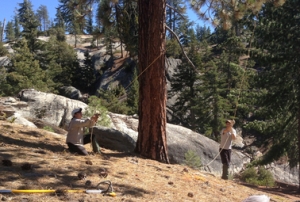Oct 23 2013
In a warming world, how far will forest species need to shift in space in order to find survivable climate conditions? And how much will temperature change on the forest floor – the landscape that serves as a nursery for tree seedlings, and thus is critical to forest survival?
 Dr. Lynn Sweet (University of California, Santa Barbara) and Dr. Pep Serra Diaz (ASU) collect Jeffrey Pine cones at Teakettle Experimental forest in the Sierra Nevada, California; seeds will be used for planting in a multi-year common garden experiment to study the effects of climate change on forests. (photo by: J. Franklin)
Dr. Lynn Sweet (University of California, Santa Barbara) and Dr. Pep Serra Diaz (ASU) collect Jeffrey Pine cones at Teakettle Experimental forest in the Sierra Nevada, California; seeds will be used for planting in a multi-year common garden experiment to study the effects of climate change on forests. (photo by: J. Franklin)
Two newly published articles by multi-university teams of researchers, including Janet Franklin, professor of geography at ASU, provide the results of investigations into these two questions.
“Species distribution modeling is the most widespread technique used to assess species exposure to future climate change impacts,” explained Josep “Pep” Serra Diaz, currently a postdoctoral researcher at ASU and leader of the first investigation. In the first of the two articles, Serra Diaz, Franklin and co-authors explain the innovative approach they developed to map the velocity of species’ exposure to climate change for endemic forest and woodland trees in California.
The method developed by the researchers calculates the rate of change in habitat suitability over both time and space as a function of projected patterns of 21st century climate change. This allows resource managers and policymakers to visualize where and at what rate are species most vulnerable to anthropogenic global warming, as a function of both how climate is predicted to change and how far the species would have to migrate to reach suitable habitat.
Serra Diaz initiated this study three years ago when he was a visiting doctoral student at ASU from Autonomous University of Barcelona and it was published just as he arrived back at ASU for a two-year postdoctoral research position with Franklin to work on the National Science Foundation-sponsored study “Do microenvironments govern macroecology?"
The second publication, which Franklin undertook together with researchers at the University of California Santa Barbara and the US Geological Survey, is an output of the same large project, whose objective is to bridge the gap between broad-brush climate models and the fine-scale spatial variations that enable plant communities to exist. Specifically, the models being developed, based on field data and theory, will predict future changes in the distribution of important oak and pine trees in California, a topographically complex and ecologically diverse region.
As one element of the project, Franklin and her colleagues worked on filling a void in prediction of near-ground temperatures. Prior to the team’s research, future climate models focused on temperatures at the height of a human – 2 meters above the ground – giving little information about changes that could impact the survival and establishment of small plant seedlings.
The study undertaken by Franklin and her co-authors demonstrated that predicting ground-surface temperatures using a downscaled climate model, coupled with temperature lapse rates from field measurements, provides a method for characterizing the temperature near the ground surface.
“On a summer day in the Sierra Nevada mountains of California, the temperature experienced by a 5-cm tall tree seedling may be more than 10°C hotter than weather station measurements at 2-meter height!” commented Franklin.
“Characterizing such microenvironments is of utmost importance for some key ecological processes at fine scales. Our research demonstrates how ground temperature affects tree seedlings establishment – which may determine future forest persistence in a warming world.”
The overall project “Do microenvironments govern macroecology?” will continue for several more years, led by Frank Davis of the University of California, Santa Barbara. At ASU, the research will be carried out by the Vegetation and Landscape Ecology Lab of the GeoDa Center for Geographic Visualization and Analysis, which Franklin directs. The GeoDa Center is a research unit of the College of Liberal Arts and Sciences.